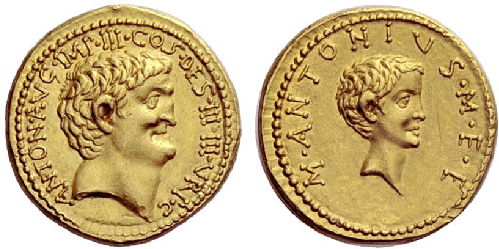All 2 entries tagged Succession
No other Warwick Blogs use the tag Succession on entries | View entries tagged Succession at Technorati | There are no images tagged Succession on this blog
July 15, 2014
Augustus and Communicating the Succession
 |
|
Augustus and Agrippa seated on a platform |
As the first emperor or princeps of Rome, Augustus' power was based solely on the positions he held and his proven achievements. There was no established mechanism by which a successor could come to power; the idea of a hereditary monarchy did not exist. Therefore the question of who or what would follow Augustus was a problem indeed, particularly since Augustus himself had no living male heir when he became seriously ill in 23 BC. After the death of her first husband, Augustus married his daughter Julia to his chief general and advisor, Agrippa. The sons of this union, Gaius and Lucius Caesar, were then adopted by Augustus in 17 BC. In order to designate them as successors these brothers were granted a series of honours and positions in spite of their young ages.
 |
|
Aureus with Augustus and Agrippa |
The entire process of appointing a successor a delicate one, and one of our first indications of an official statement of dynastic ideology can be found in a series of coins issued at Rome in 13 BC. This was the year the tribunician power of Augustus and Agrippa was renewed, and Agrippa is shown on the coinage as Augustus' colleague (just as he is later named as a colleague in the Res Gestae Divi Augusti 8.2). Coins show Augustus and Agrippa side-by-side: on the coin above, the portrait of Augustus graces the obverse, while Augustus and Agrippa are seated in togas on the reverse (RIC 12 407). Other issues of this year display the head of Augustus on one side, and the head of Agrippa on the other. On the silver denarius issue of this type, both Augustus and Agrippa are bare-headed, while on the gold aureus issue shown here Augustus wears an oak-crown (an honour granted him by the Senate) and Agrippa a combined mural and rostral crown, which combined the walls of a city and the prow of a ship (RIC 12 409). Silver denarii were also struck showing Julia and her two sons: the obverse carries the portrait of Augustus accompanied by a lituus, and the reverse displays the bust of Julia with a wreath above it, flanked by the busts of her sons (RIC 12 404-5).
 |
|
Denarius showing Julia between Gaius and Lucius |
Alas, the following year Agrippa died, and Gaius and Lucius would both also die before Augustus. It was this series of unfortunate deaths that meant that Tiberius would marry Julia and as Augustus' adopted son, become the successor of his power and offices.
(Images are © The Trustees of the British Museum).
Good images of all of Augustus' coinage can also now be found on the Online Coins of the Roman Empire site.
February 13, 2014
Succession and the Aurei of Mark Antony
 |
| Aureus showing Antony and his son Antyllus |
The problem of succession, and Augustus' means of communicating succession, form a key theme in the study of the Augustan principate. But the mechanisms for communicating succession and dynasty in the principate arose directly out of the Republic, in particular the strategies employed during the civil wars. We can see this in a gold aureus series struck for Mark Antony in 34 BC while he was triumvir in the East (RRC 541/1-2). The design of this series foreshadows how imperial dynasty and succession would later be communicated during the Roman Empire.
The coin issue consisted of two different types, but both of them carried the portrait of Mark Antony on the obverse and the portrait of his eldest son Marcus Antonius Antyllus on the reverse. Antyllus was the child of Antony and Fulvia, and was at one point engaged to Octavian's daughter Julia. His appearance on coinage here suggests that Antony may have been attempting to establish and advertise a successor, well before Augustus would later turn to the problem.
This is also suggested by the legends of these pieces. On the first type, the titles of Antony occupy both the obverse and reverse of the coin (M ANTONI M F M N AVG IMP TERT, COS ITER DESIG TERT III VIR R P C, Marcus Antonius, son of Marcus, grandson of Marcus, Augur, Imperator for the third time, consul for the second time, consul designate for the third time, triumvir for the establishment of the Republic). That Antony included the names of his father and grandfather must have been intentional: in contrast to Octavian's claims to be the son of the divine Caesar, Antony represents his descent in a traditional Roman manner, something which may have appealed to the Senate rather more than Octavian's claims. One the second type of this issue (shown above), Antony's titles are abbreviated and confined to the obverse of the coin, while the reverse carries the name of Marcus Antonius Antyllus, who is presented as the son of Antony (M ANTONIVS M F F). Thus over both types, Antony and his positions are communicated, as is Antony's ancestry and his successor, a presentation that is remarkably similar to what would occur later in the imperial period.
Coin image reproduced courtesy of Numismatica Ars Classica NAC AG (Auction 54, Lot 285)
 Clare Rowan
Clare Rowan

 Please wait - comments are loading
Please wait - comments are loading

 Loading…
Loading…

